Green gemstones capture the eye with their myriad hues, ranging from the palest mint green to the deepest forest green. Their popularly admired shades symbolize nature, vitality, and prosperity. A rich tradition surrounds these precious stones, as they have been adorned and valued for centuries across various cultures.
Essential factors such as colour, clarity, tone, and translucence play a crucial role in determining their value and significance.
A spectrum of green gems exists, each with unique properties and uses. Emeralds, with their vibrant verdancy, have long been associated with luxury and status. Other gems like peridot, jade, and green tourmaline offer a diverse array of choices in jewellery, with varying degrees of hardness and suitability for daily wear. Their captivating colour can be attributed to the presence of trace elements like chromium, vanadium, or iron within their mineral structure.
The physical and metaphysical aspects of green crystals are often brought to light, with many people attributing particular healing properties or spiritual properties to these stones.
From the sparkle of a faceted emerald to the opaque charm of malachite, green gemstones are as diverse as they are popular. They are sought after for their beauty and the unique characteristics they bring to the world of gems and jewellery.
💚 Love green gemstones? Shop our Green Jewellery Collection or explore best-sellers like Mighty Mossy Oaks, Canada Jade Cuff, and Emerald Oasis.
Key Takeaways
-
Green gemstones are celebrated for their rich colour and historical significance.
-
Factors like colour, clarity, and tone are essential in assessing the quality of these gems.
-
Green gems come in a variety of hues and qualities, suitable for different jewellery applications.
The Significance of Colour in Green Gemstones
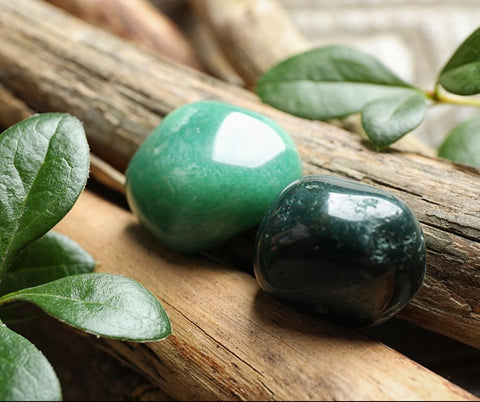
When discussing green gemstones, their colour is paramount, reflecting more than mere appearance.
Green speaks to life and renewal, with each shade and hue imparting distinct characteristics and perceived value.
The tone of green in gemstones can range from light green to dark green, influencing both aesthetics and the meaning of green colours.
A pale green may suggest growth and the freshness of new beginnings, while a deeper green might be associated with prosperity and well-being.
The hue, the actual colour, can be pure green or may have secondary hues of blue or yellow.
Gemstones with a pure green shade without any hints of other colours are typically more sought after and thus may command higher prices.
The colouration in green gemstones is often due to the presence of elements such as chromium and nickel.
For instance, the vivid green of an emerald is typically due to chromium, which imparts a rich, saturated colour. In contrast, nickel can produce a softer green.
Here is a brief overview of how colour variations in green stones can affect their attributes:
| Tone | Significance |
| Light Green | Growth, Freshness |
| Dark Green | Prosperity, Well-being |
| Pale | Beginnings, Renewal |
In assessing green gemstones, gemologists consider three attributes: hue, tone, and saturation.
A stone's saturation, or colour intensity, plays a significant role in its overall visual impact.
High saturation levels result in bold, vivid gemstones that are often more desirable in jewellery settings.
Therefore, green gemstones encapsulate a variety of tones and hues, each contributing to the overall perception and significance of these natural world treasures.
Exploring Popular Green Gemstones
The allure of green gemstones in jewellery is timeless, with certain varieties holding esteemed positions as birthstones and sought-after treasures. These stones are prized for their range of hues, durability, and unique properties that make them favourites in collections and heirloom pieces.
Emeralds
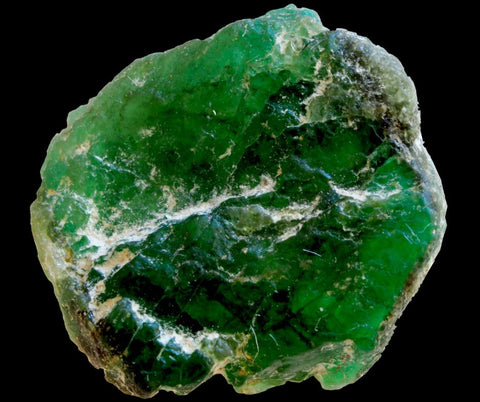
Emeralds, known for their rich, saturated green, are among the most valued gemstones. They serve as the birthstone for May and are a popular choice in high-end jewellery.
Their popularity stems from both their vibrant colour and the belief in their power to symbolize rebirth and love.
However, it's important to note that emeralds often contain inclusions, which can affect their clarity. When selecting an emerald, buyers should consider the balance between clarity and the intensity of colour. Shop Emerald → Emerald Oasis Set
Peridots
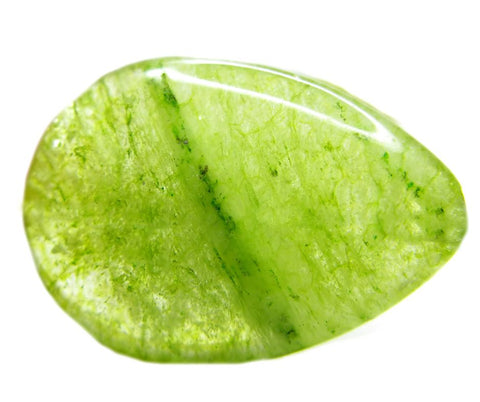
Peridots possess a distinct lime green colour that can range from yellowish-green to olive green tones. This gemstone, which is also the birthstone for August, has increased in popularity due to its lively, bright appearance and affordability.
While peridots are generally not as hard as emeralds, with a Mohs hardness of around 6.5 to 7, they are nevertheless suitable for a variety of jewellery pieces, including rings, earrings, and necklaces.
Green Tourmalines
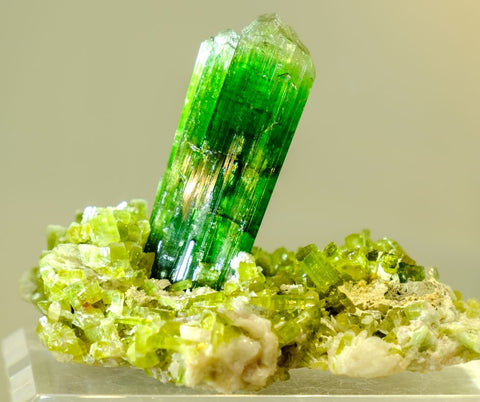
Green Tourmalines are versatile gemstones that come in a spectrum of green shades, from light pastels to deep forests.
Their broad colour range and availability in large sizes make them a favoured option for statement jewellery.
Tourmalines are also known for their durability, ranking a 7 to 7.5 on the Mohs scale, making them a practical choice for daily wear.
Their popularity is consistent due to their often reasonable pricing and the variety they offer to designers.
Green Garnets
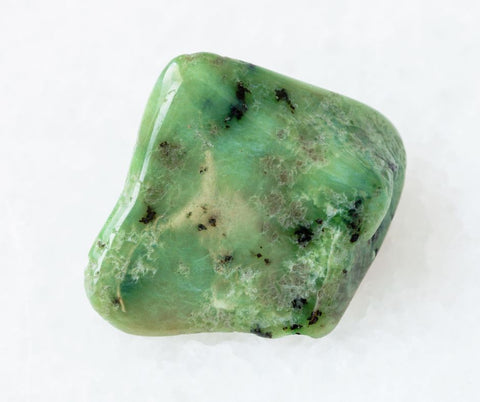
Green Garnets, particularly the varieties known as Tsavorite and Demantoid, showcase vibrant green hues and exceptional brilliance.
Tsavorite can exhibit a bright grass-green colour, while Demantoid is valued for its unique green with a yellowish cast and sometimes displays a rare 'horsetail' inclusion pattern.
These green garnets are relatively hard, between 6.5 and 7.5 on the Mohs scale, which, along with their rarity, contributes to their desirability in jewellery.
Green Agate
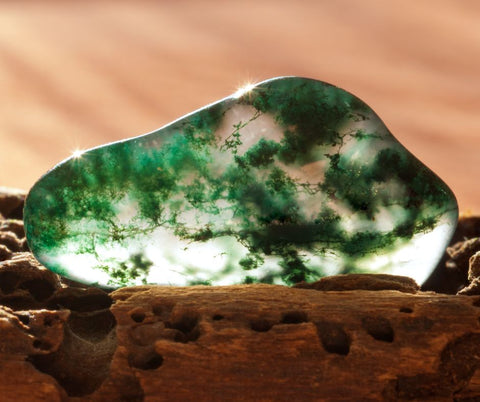
Green Agates are a captivating group within the agate family, known for their soothing green shades and intricate patterns. These gemstones are not only beautiful but also carry symbolic meanings of harmony, balance, and renewal.
Among the varieties, Moss Agate stands out for its moss-like inclusions, creating unique landscapes within each stone. This variety does not have the concentric banding typical of agates, which makes it distinctive.
Other notable green agate varieties include Dendritic Agate, with its tree or fern-like patterns, and Green Eye Agate, known for its circular patterns that resemble eyes. These stones are relatively durable, with a Mohs hardness of around 6.5 to 7, making them suitable for various types of jewelry. Their appeal lies in the natural beauty and the tranquil vibe they bring to pieces.
Green Jaspers
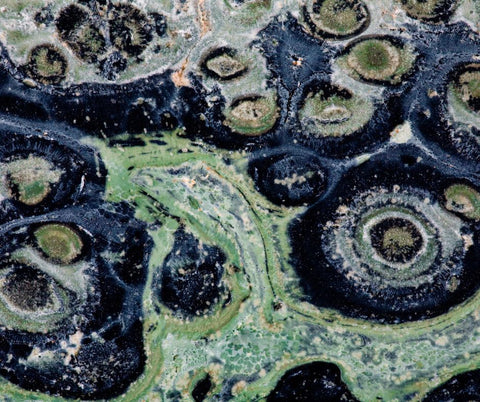
Green Jaspers are another group of gemstones celebrated for their durability and decorative appeal. Jasper, a form of chalcedony, presents in a range of green hues, from pale seafoam to deep olive. This stone is often associated with grounding and nurturing energies, making it a popular choice for those seeking a connection with nature through their jewelry.
Varieties like Rainforest Jasper, with its patterns reminiscent of a verdant jungle, and Kambaba Jasper, featuring ancient fossilized algae that create swirling green and black patterns, are particularly sought after. With a Mohs hardness of about 6.5 to 7, green jaspers are robust enough for everyday wear, offering a blend of aesthetic appeal and symbolic significance. Shop Jasper → Harvest Lynx
Green Fluorite
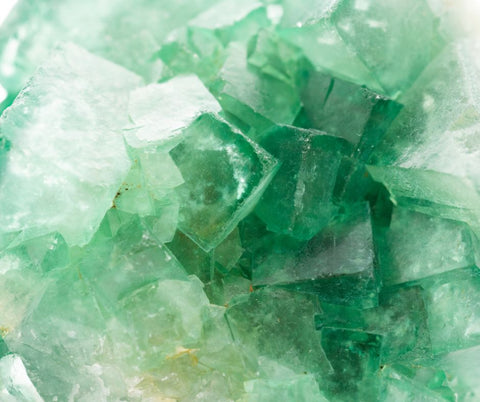
Green Fluorite is prized for its stunning clarity and vibrant hues, ranging from pale mint to deep emerald greens. This gemstone is known for its fluorescent properties, with some specimens glowing under ultraviolet light.
Green Fluorite is believed to promote healing, growth, and renewal, making it a meaningful addition to jewelry collections. Its crystal structure allows for a high polish, resulting in eye-catching pieces that showcase its depth and clarity. However, with a Mohs hardness of 4, it is softer than many other gemstones, requiring careful handling to avoid scratches and chips.
Despite this, its beauty and the positive energies it is said to carry make it a cherished choice for those drawn to its luminescent charm.
Green Apatite

Green Apatite, with its translucent to transparent appearance, offers a range of green tones from soft lime to deep forest green. This gemstone is known for its connection to nature and the environment, symbolizing growth, vitality, and the life force of the natural world.
Green Apatite's allure is not just in its colour but also in its rare neon and electric green varieties, which are highly coveted. With a Mohs hardness of 5, it is relatively soft, making it more suitable for pendants and earrings than high-wear items like rings.
Its unique hues and the sense of connection to the earth it provides make Green Apatite a fascinating choice for designers looking to create pieces with depth and meaning.
Green Calcite
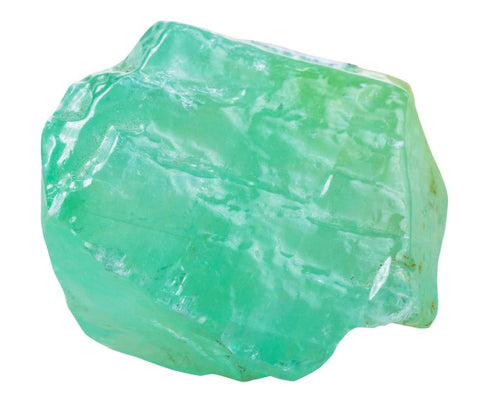
Green Calcite is celebrated for its soothing, pale green shades and smooth, waxy lustre. This gemstone is often sought after for its purported properties of mental healing and rejuvenation. It is believed to encourage relaxation and emotional balance, making it a popular choice for those seeking peace and tranquillity through their jewelry.
Green Calcite's softness, with a Mohs hardness of just 3, means it is best used in pieces that are not exposed to rough wear. Its gentle glow and the calming energy it is said to bring make it a unique and meaningful addition to any collection, perfect for creating pieces that offer more than just physical beauty.
More Beautiful Green Gemstone Varieties
Seraphinite
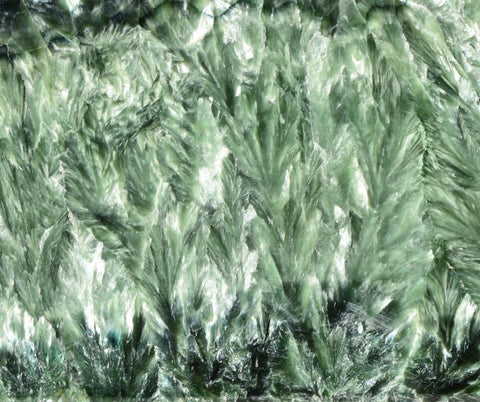
With its deep green colour and feather-like patterns, seraphinite is associated with spiritual growth and its strong healing powers.
Chrysocolla

Chrysocolla blends green with blue, symbolizing communication and expression.
Bloodstone
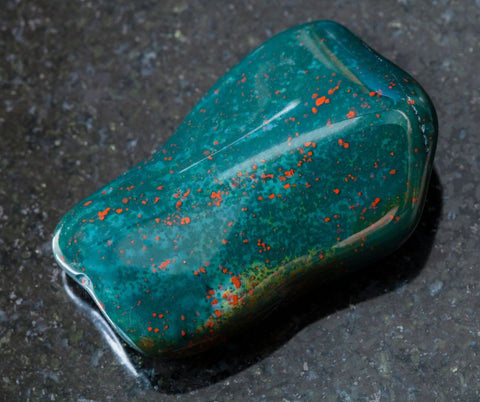
Bloodstone, or heliotrope, is a dark green jasper with red spots known for its protective qualities.
Uvarovite
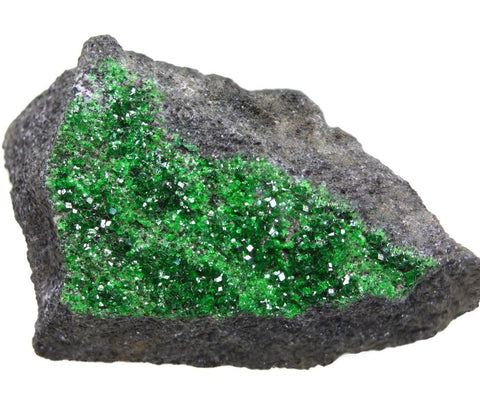
Uvarovite garnet is admired for its vibrant, emerald-green crystals and rarity.
Prehnite
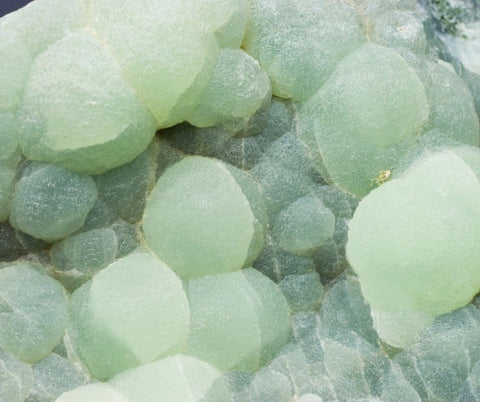
Prehnite offers a pale to medium green colour, valued for its beauty and supposed memory-enhancing properties.
Vesuvianite
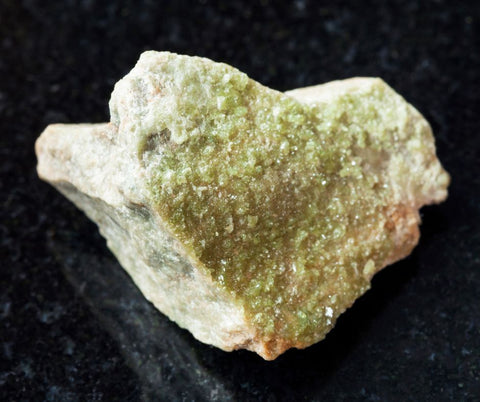
Vesuvianite features a range of green shades, from pale to deep green, prized for its clarity and lustre.
Dioptase

Dioptase is notable for its intense emerald-green colour and transparency, making it a favourite among collectors.
Green Gemstones and Their Properties
This section explores the distinctive characteristics and qualities of select green gemstones, focusing on their physical properties such as hardness, lustre, and durability.
Jade

Hardness: 6-7 on the Mohs scale
Luster: Waxy to vitreous
Durability: Exceptionally tough due to its interlocking crystal structure
Jade refers to two different minerals, nephrite and jadeite, both prized for their toughness and smooth lustre.
Nephrite typically exhibits a more opaque look, while jadeite offers a translucent to semi-transparent appearance. Shop Jade → Canada Jade Cuff
Tsavorite
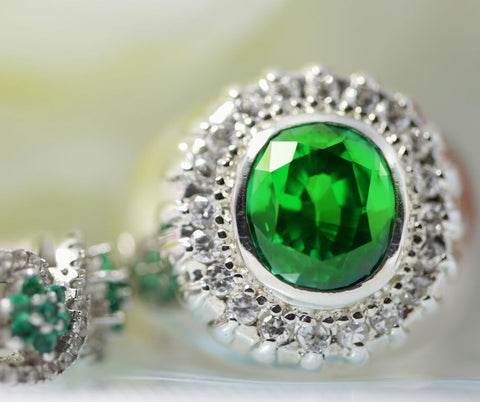
Hardness: 7-7.5 on the Mohs scale
Luster: Vitreous
Durability: Good, but care should be taken to protect it from scratches and hard blows
Tsavorite is a variety of garnets known for its bright emerald-like green colour. It is highly sought after due to its brilliance and is often used in fine jewelry.
Malachite
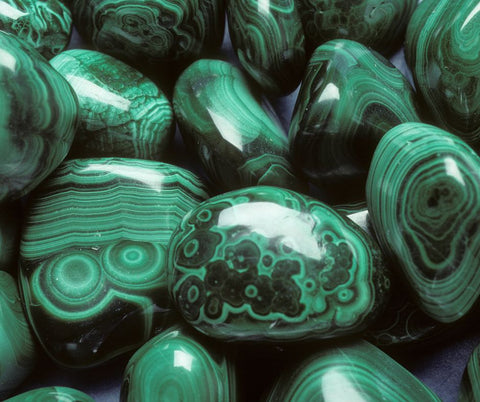
Hardness: 3.5-4 on the Mohs scale
Luster: Silky to subvitreous
Durability: Fair; the stone is relatively soft and sensitive to acids and heat
Malachite is easily recognizable by its banded light and dark green designs. Despite its lower hardness, it is popular for its unique patterns and is often used for ornamental purposes. Shop Malachite → Malachite Drop Earrings
Green Sapphire
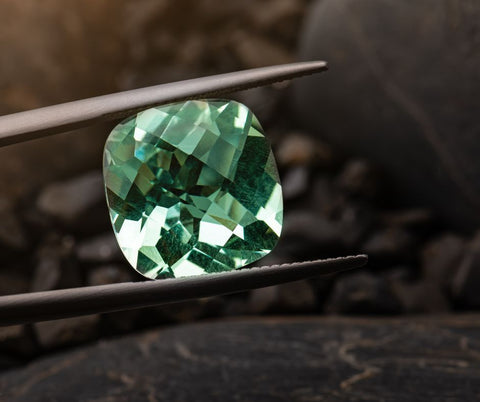
Hardness: 9 on the Mohs scale
Luster: Vitreous
Durability: Excellent due to its high hardness, making it suitable for everyday wear
Green sapphire, a colour variant of the corundum family, ranges in hue from pale yellow green to deep intense green.
Though less common than blue sapphire, it is valued for its rarity and significant hardness.
Rare and Exotic Green Gem Varieties
This section explores a selection of green gemstones that are known for their rarity and distinctive properties. Each subsection delves into the characteristics that make these gems both exotic and sought after by collectors and jewellery enthusiasts.
Chrome Diopside
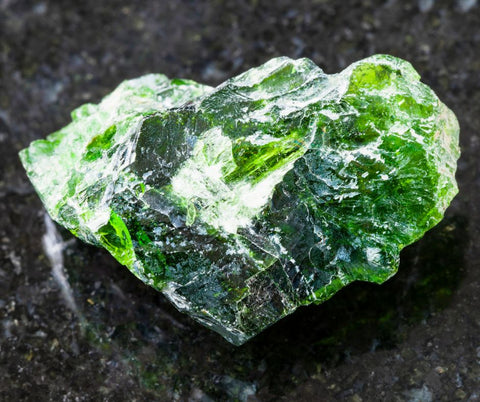
Chrome Diopside, a gem that is celebrated for its rich green colour, hails primarily from remote locations in Russia.
It's a calcium magnesium silicate with a Mohs hardness rating of 5.5 to 6.5, making it relatively soft for jewellery use.
The intensity of its green hue is due to the presence of chromium, and while it’s less commonly known, it’s prized for its vivid colour and affordability compared to other green gemstones.
Hiddenite

Hiddenite is the green variety of spodumene and was first discovered in North Carolina. It can range from a pale green color to a rich, emerald-like hue.
Its relative rarity is due to its strict colouration requirements and very limited global deposits.
Hiddenite’s value increases with the depth of its green colour, and it often demands high prices due to its rarity and quality.
Demantoid
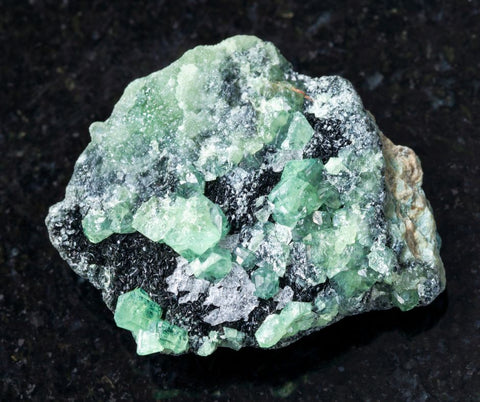
Demantoid is part of the garnet family and is distinguished by its brilliance and fire—properties that often surpass even that of diamonds.
Originating mainly from Russia, it exhibits a vibrant green hue, sometimes with a yellowish tinge.
Demantoid is both rare and expensive, and high-quality stones featuring horsetail inclusions are particularly coveted by collectors.
Green Aventurine
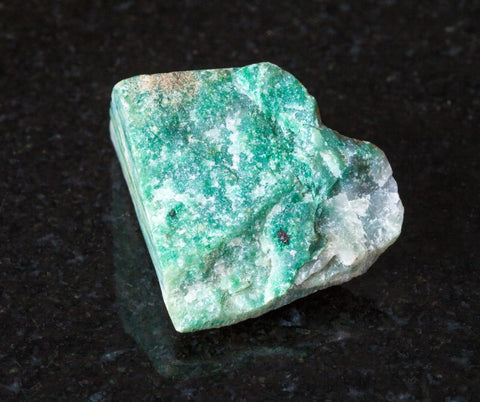
Green Aventurine is known for its shimmering effect, known as aventurescence, which is caused by tiny platelets of minerals within the stone.
Although aventurine can be found in multiple colours, the green variant is the most common.
It is often used in cabochons, beads, and ornamental objects rather than fine jewellery, due to its abundance and modest price point compared to other rare green gemstones.
Green Apophyllite
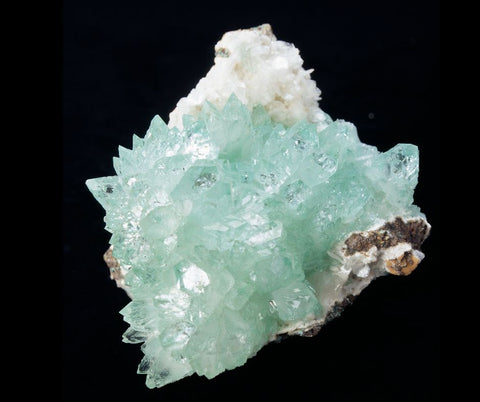
Green Apophyllite is a rare and visually striking mineral known for its vibrant green colour and unique tetragonal crystal formations. Predominantly found in India, as well as in Brazil, the USA, and Scotland, it is highly sought after by collectors and those interested in its metaphysical properties.
Revered for its ability to promote emotional healing and enhance spiritual connections, Apophyllite is associated with heart chakra healing, making it a cherished gem in both aesthetic and spiritual realms. Its captivating appearance and purported healing qualities make it a valuable addition to any collection or healing practice.
Green Gemstones by Clarity and Translucence
Green gemstones are cherished for their range of colours and degrees of clarity and translucence. Each green stone's appearance is influenced by its individual properties, including the presence of inclusions.
Jadeite and nephrite, two types of jade, often have a smooth, opaque appearance.
Jadeite can occasionally be found with a degree of translucence, enhancing its value. Nephrite typically presents a more subdued, creamy appearance, both materials well-regarded for their toughness.
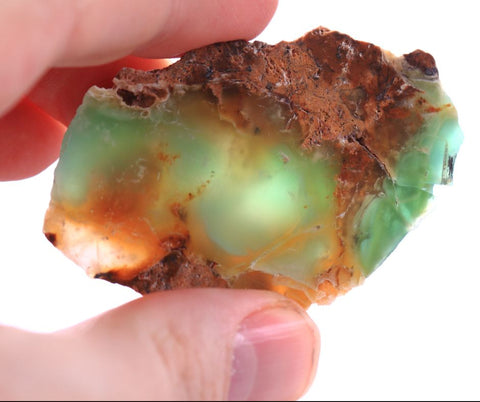
Chrysoprase, notable for its apple-green hue, often exhibits translucency. It is highly prized when it has minimal inclusions, which can make the gemstone appear more opaque.
-
Clarity:
-
Jadeite: Translucent to opaque; higher translucence increases desirability.
-
Nephrite: Commonly opaque with a creamy appearance.
-
Chrysoprase: Translucent; highly valued with few inclusions.
-
Inclusions, while sometimes seen as flaws, can contribute to the character of a gemstone.
Stones with fewer inclusions are often more transparent and considered more valuable.
However, certain inclusions can create unique effects or patterns that are sought after by collectors and jewelry enthusiasts.
Translucency in green gemstones varies widely, with some, like certain emeralds, being more transparent.
Translucent green gemstones allow light to pass through, but not with the perfect clarity a transparent stone would offer.
This metric often impacts the gemstone's appeal and price point, as perfectly clear specimens are rare and highly coveted.
Physical and Metaphysical Aspects of Green Crystals
Green crystals are treasured both for their beauty and their wide-ranging metaphysical and healing properties.
They often symbolize spiritual growth and renewal, akin to the verdant hues found in nature.
The physical attributes of green crystal stones, such as emerald, peridot, and malachite, include a spectrum of colours from soft, pale greens to deep, rich emerald tones.
Clarity varies among types, with some being translucent and others opaque.
The metaphysical qualities attributed to these stones connect them to the heart chakra.
They are believed to foster balance and harmony within the emotional landscape of an individual.
Various green gemstones are associated with different aspects of healing, life energy and well-being:
-
Emerald: Said to enhance love and fidelity.
-
Malachite: Known for its power to protect and cleanse.
-
Peridot: Associated with abundance and prosperity.
-
Jade: Often linked to wisdom and serenity.
In the realm of emotional healing, practitioners often recommend these stones to assist in fostering compassion and understanding.
They purport that the stones help to calm the spirit and encourage a balanced emotional state.
| Stone | Healing | Prosperity | Balance | Heart Chakra |
| Emerald | Emotional | Yes | Yes | Yes |
| Malachite | Protection | - | Yes | Yes |
| Peridot | Physical | Yes | - | Yes |
| Jade | Harmony | Yes | Yes | Yes |
Physical and metaphysical characteristics combine in these gemstones, making them desirable for jewelry with purpose.
They are not just ornamental but are also carried or worn to attract specific energies and intentions related to strength and abundance.
Green Gemstones for Jewelry and Adornment
Green gemstones are celebrated for their diverse shades and connections to nature, symbolizing growth, harmony, and balance. These captivating stones are a favourite among designers, who skillfully incorporate them into a variety of jewelry settings, from traditional elegance to contemporary chic.
Alexandrite is renowned for its extraordinary colour-changing ability, transitioning from lush green in daylight to a rich red under incandescent light. This rare gemstone is highly valued for its unique phenomenon, requiring careful handling to preserve its magical qualities.

Quartz, known for its durability and abundance, offers green crystal varieties such as Prasiolite. This green quartz, with its soft, serene hue, is often set in silver or gold, creating pieces that exude understated elegance. Prasiolite jewelry is easy to care for, making it an ideal choice for daily adornment.
Green Tanzanite adds a rare and exotic touch to the green gemstone palette. This unique variant of Tanzanite displays shades from light, minty greens to rich olives, offering a refreshing alternative to its more commonly known blue-violet counterpart. The rarity and trichroic nature of Green Tanzanite, showing different colours from various angles, make it a sought-after gem for distinctive, luxurious jewelry pieces.
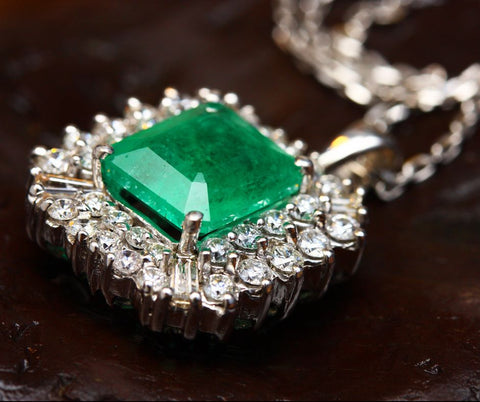
When choosing green gemstones for jewelry, it's important to consider the stone's hardness and the care it requires to ensure its lasting beauty. Softer green gems may benefit from protective settings to guard against scratches, while harder stones, like quartz, offer greater resilience. Each green gemstone brings its own charm and character to jewelry designs, allowing for personal expression and connection to the natural world.
The table below lists the most popular green gemstones and their typical uses in jewelry:
| Green Gemstone | Typical Use in Jewelry | Care Tips |
| Alexandrite | Statement pieces, engagement rings | Avoid harsh chemicals, store separately |
| Quartz (Prasiolite) | Earrings, necklaces, bracelets | Mild soap and water, soft cloth for cleaning |
| Emerald | High-end jewelry, special occasions | Professional cleaning advised |
| Peridot | Pendants, rings, versatile for various designs | Avoid exposure to extreme temperatures |
Jewelry designers often experiment with these green stones to create pieces that are both visually striking and symbolic.
Whether set in a minimalist ring or a lavish necklace, green gemstones contribute significantly to the world of jewelry and adornment.
Assessing the Quality of Green Gemstones
When assessing green gemstones, gemologists consider several factors to ascertain their quality. The evaluation of quality involves an analysis of colour, clarity, cut, carat weight, and the presence of inclusions.
Colour is crucial in determining a gemstone's value.
The most prized green gemstones display a vibrant, verdant hue.
Green diamonds and green zircon, for example, are assessed for their hue, tone, and saturation.
A pure green stone is highly sought after, though some green gemstones with bluish or yellowish tints can also be desirable.
-
Hue: Refers to the gemstone's base colour.
-
Tone: Indicates the lightness or darkness of the green hue.
-
Saturation: Describes the intensity of the green colour.
Clarity refers to the absence of inclusions or imperfections within the gemstone.
Inclusions can detract from the gemstone's beauty and value; however, some stones, like emeralds, are typically treated more leniently regarding inclusions due to their natural occurrence.
Cut impacts a green gemstone's ability to reflect light and relates to the symmetry and proportions of the facets. A well-cut green gem will exhibit more brilliance and scintillation.
Carat weight measures the gemstone's size, with larger stones generally being more valuable due to their rarity.
However, two gemstones of equal carat weight can vary drastically in value depending on the other quality factors.
Geological Formation and Sources of Green Gemstones
Green gemstones originate from various geological processes deep within the Earth. They are often excavated from regions rich in specific mineral compositions conducive to their formation.
One of the most recognized green gemstones, emerald, is a member of the beryl mineral family, formed under high pressure and temperature conditions, typically in pegmatite rock.
-
Sources: Major sources of green gemstones such as emeralds include mines in Colombia, Zambia, and Brazil. Regions well-known for their prolific gemstone yield.
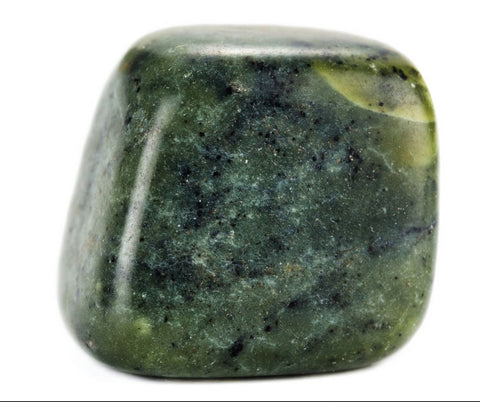
-
Formation: The mineral serpentine is formed through the hydration and metamorphic transformation of ultramafic rocks from the Earth's mantle.
-
Regions: In particular, serpentine is often sourced from locations known for ophiolites, where oceanic crust and mantle rocks are exposed on the Earth's surface.
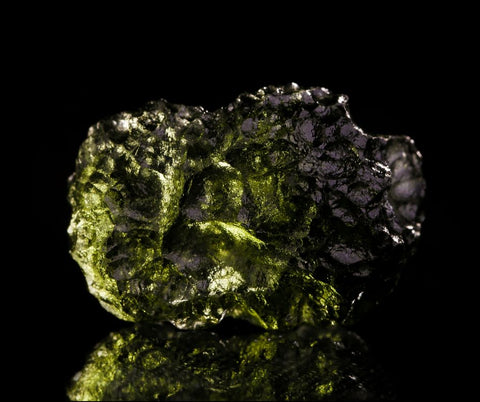
Unique to Czech regions near the Vltava River, moldavite is a green tektite formed by meteorite impacts.
Its distribution is exclusively linked to a specific event, making it rare and geologically fascinating.
Zircon, another mineral that can display a green hue, crystallizes from molten rock masses or magma as it cools.
While not all zircon is a green mineral, the green variety can be found in granitic formations or metamorphic rocks.
| Gemstone | Typical Sources | Geological Formation |
| Emerald | Colombia, Zambia, Brazil | Pegmatite, hydrothermal veins |
| Serpentine | Ophiolite complexes worldwide | Hydration of ultramafic rocks |
| Moldavite | Czech Republic (Vltava River area) | Tektite from meteorite impacts |
| Zircon | Australia, Asia, North America | Crystallized from cooling magma |
Caring for Your Green Gemstone Collection
Proper care and maintenance are critical for preserving the beauty and integrity of green gems, such as variscite and gaspeite. Collectors should consider several important factors when handling their prized green crystals.
Storage:
-
Store each gemstone separately to prevent scratches or chips.
-
Use a fabric-lined jewellery box or individual soft pouches.
-
Keep them away from direct sunlight, which can cause fading over time.
Cleaning:
-
Clean most green crystals with a soft, damp cloth after wearing.
-
Avoid harsh chemicals; even mild soaps may leave a residue.
-
For stones like variscite, utilize a gentle touch to avoid damaging the stone's surface.
Maintenance:
-
Regularly inspect settings for loose stones, especially in jewellery.
-
Have a professional jeweller check and clean your gemstones annually.
Special Considerations for Variscite and Gaspeite:
-
Both are relatively soft stones and can be easily scratched.
-
Avoid ultrasonic cleaners; they can be too harsh for these delicate stones.
-
Wipe with a slightly moistened cloth and immediately dry with a soft, lint-free fabric.
Green Gemstones in Cultural and Historical Contexts
Green stones have been esteemed throughout history for their captivating hues and symbolic meanings.
Emeralds, one of the most renowned green gemstones, play a pivotal role in numerous cultures.
The ancient Egyptians mined emeralds as early as 1500 BCE, and they associated these beryl gemstones with fertility and rebirth.
In South America, the Incas and Aztecs also held emeralds in high regard, using them in their elaborate jewellery and ritualistic items.
The influence of green gemstones extends into various cultural traditions.
In Hinduism, for example, green beryl is said to represent the planet Mercury and is worn to enhance intellect and business acumen.
Meanwhile, the green hues of these stones are often linked with nature, life, and health in Western symbolism.
Turquoise has been integral to Native American culture, especially amongst Southwestern tribes.
It's considered a stone of protection and has been utilized in healing rituals and as a symbol of status and wealth.
The distinct blue-to-green shades of turquoise often decorate traditional jewellery and adornments.
In metaphysical circles, aventurine is believed to attract prosperity and soothe emotions.
This quartz mineral is frequently carved into figurines or used in various healing practices.
Each gemstone carries its own distinctive story, merging history with modern-day beliefs.
Lastly, across many traditions, green gemstones are often gifts for milestone anniversaries.
Emeralds, in particular, are traditional gifts for the 20th and 35th wedding anniversaries, celebrating enduring love and commitment.
| Gemstone | Cultural Significance | Historical Context |
| Emeralds | Symbol of rebirth (Egypt); Mercury (Hinduism) | Mined in Egypt (1500 BCE); Incas & Aztecs |
| Aventurine | Attracts prosperity; Emotional healing | Used in figurines; Metaphysical practices |
| Turquoise | Protection; Status (Native American) | Southwestern tribes; Healing rituals |
Frequently Asked Questions
In exploring green gemstones and crystals, one frequently encounters questions about identification, meanings, rarity, and valuation, as well as queries about specific colour hues.
What are some common types of green gemstones and crystals?
Common green gemstones include emerald, peridot, jade, and malachite.
Each bears unique characteristics, with emeralds known for their rich colour and peridot sporting a brighter olive hue.
Jade is revered for its creamy texture, while malachite is easily recognized by its banded light and dark green patterns.
How can one identify different green gemstones?
To identify green gemstones, professionals assess colour, clarity, crystal shape, structure, and hardness.
Tools such as a jeweller's loupe allow for detailed examination of inclusions which can provide clues to a gemstone's identity.
For example, emeralds often have characteristic inclusions sometimes referred to as 'jardin', which is French for 'garden'.
What are the meanings associated with various green crystals?
Different green crystals are often associated with specific meanings.
For instance, emeralds are traditionally linked to love and rebirth.
Peridot, with its bright green sparkle, is seen as a symbol of positive energy and power.
Green jade carries connotations of purity and serenity, and malachite is often thought to represent transformation and healing.
Which green gemstone is considered the rarest?
Among green gemstones, the rarest is generally considered to be the green diamond.
Its rarity is due to the infrequency with which the specific geological conditions needed to create its colour occur.
Other rare green gemstones include demantoid garnet and alexandrite.
How is the value of green gemstones determined?
The value of green gemstones is determined by a combination of factors, including colour saturation, transparency, size, and rarity.
Market demand also plays a significant role in valuation.
For example, a high-quality emerald's value lies heavily in its colour and clarity, while peridot is often valued for its intense, unadulterated green hue.
Can you list green gemstones that are typically darker in hue?
Green gemstones that are typically darker in shade include deep green tourmaline, also known as verdalite, and chrome diopside.
Both are known for their rich, forest green shades.
Other dark-hued green stones include serpentine, which offers a translucent to opaque appearance, and dark jade varieties.









